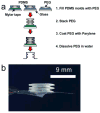An implantable MEMS micropump system for drug delivery in small animals
- PMID: 22273985
- PMCID: PMC3348997
- DOI: 10.1007/s10544-011-9625-4
An implantable MEMS micropump system for drug delivery in small animals
Abstract
We present the first implantable drug delivery system for controlled timing and location of dosing in small animals. Current implantable drug delivery devices do not provide control over these factors nor are they feasible for implantation in research animals as small as mice. Our system utilizes an integrated electrolysis micropump, is refillable, has an inert drug reservoir for broad drug compatibility, and is capable of adjustment to the delivery regimen while implanted. Electrochemical impedance spectroscopy (EIS) was used for characterization of electrodes on glass substrate and a flexible Parylene substrate. Benchtop testing of the electrolysis actuator resulted in flow rates from 1 μL/min to 34 μL/min on glass substrate and up to 6.8 μL/min on Parylene substrate. The fully integrated system generated a flow rate of 4.72 ± 0.35 μL/min under applied constant current of 1.0 mA while maintaining a power consumption of only ~3 mW. Finally, we demonstrated in vivo application of the system for anti-cancer drug delivery in mice.
Figures













Similar articles
-
MEMS: Enabled Drug Delivery Systems.Adv Healthc Mater. 2015 May;4(7):969-82. doi: 10.1002/adhm.201400772. Epub 2015 Feb 20. Adv Healthc Mater. 2015. PMID: 25703045 Review.
-
A MEMS electrochemical bellows actuator for fluid metering applications.Biomed Microdevices. 2013 Feb;15(1):37-48. doi: 10.1007/s10544-012-9685-0. Biomed Microdevices. 2013. PMID: 22833156 Free PMC article.
-
[Analysis and test of piezoelectric micropump for drug delivery].Sheng Wu Yi Xue Gong Cheng Xue Za Zhi. 2005 Aug;22(4):809-13. Sheng Wu Yi Xue Gong Cheng Xue Za Zhi. 2005. PMID: 16156279 Chinese.
-
Implantable MEMS drug delivery pumps for small animal research.Annu Int Conf IEEE Eng Med Biol Soc. 2009;2009:6696-8. doi: 10.1109/IEMBS.2009.5333284. Annu Int Conf IEEE Eng Med Biol Soc. 2009. PMID: 19964178
-
BioMEMS devices for drug delivery.IEEE Eng Med Biol Mag. 2009 Jan-Feb;28(1):31-9. doi: 10.1109/MEMB.2008.931014. IEEE Eng Med Biol Mag. 2009. PMID: 19150769 Review. No abstract available.
Cited by
-
A 3D-Printed Modular Microreservoir for Drug Delivery.Micromachines (Basel). 2020 Jun 30;11(7):648. doi: 10.3390/mi11070648. Micromachines (Basel). 2020. PMID: 32629848 Free PMC article.
-
Neural probe system for behavioral neuropharmacology by bi-directional wireless drug delivery and electrophysiology in socially interacting mice.Nat Commun. 2022 Sep 21;13(1):5521. doi: 10.1038/s41467-022-33296-8. Nat Commun. 2022. PMID: 36130965 Free PMC article.
-
An Additive Manufacturing Technique for the Facile and Rapid Fabrication of Hydrogel-based Micromachines with Magnetically Responsive Components.J Vis Exp. 2018 Jul 18;(137):56727. doi: 10.3791/56727. J Vis Exp. 2018. PMID: 30080207 Free PMC article.
-
In-Vivo Microsystems: A Review.Sensors (Basel). 2020 Sep 1;20(17):4953. doi: 10.3390/s20174953. Sensors (Basel). 2020. PMID: 32883011 Free PMC article. Review.
-
Recent Advances in Micro-Electro-Mechanical Devices for Controlled Drug Release Applications.Front Bioeng Biotechnol. 2020 Jul 29;8:827. doi: 10.3389/fbioe.2020.00827. eCollection 2020. Front Bioeng Biotechnol. 2020. PMID: 32850709 Free PMC article. Review.
References
-
- Alzet. [Accessed October 19, 2011a];ALZET® Osmotic Pumps - Implantable pumps for research. Available at: http://www.alzet.com/
-
- Ambati J, et al. Transscleral delivery of bioactive protein to the choroid and retina. Investigative Ophthalmology and Visual Science. 2000;41(5):1186–1191. - PubMed
-
- Amirouche F, Zhou Y, Johnson T. Current micropump technologies and their biomedical applications. Microsystem Technologies. 2009;15:647–666.
-
- Bard A. Electrochemical methods: fundamentals and applications. 2. New York: Wiley; 2001.
-
- Belmont C, Girault HH. Coplanar interdigitated band electrodes for synthesis Part I: Ohmic loss evaluation. Journal of Applied Electrochemistry. 1994;24:475–480.
Publication types
MeSH terms
Substances
Grants and funding
LinkOut - more resources
Full Text Sources
Other Literature Sources

